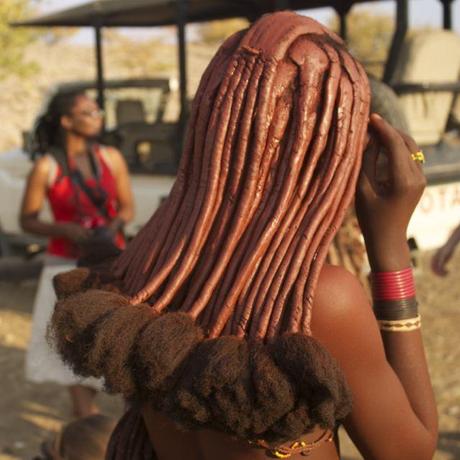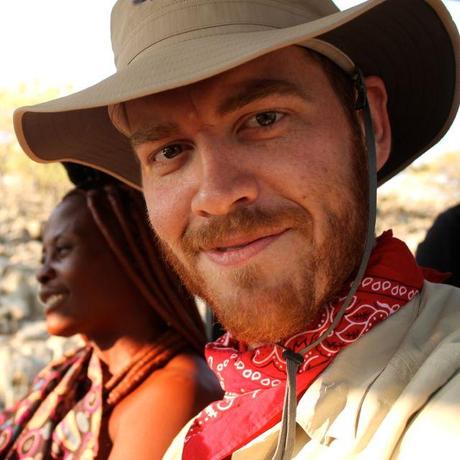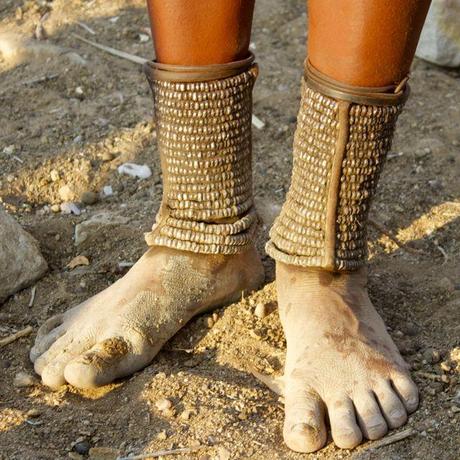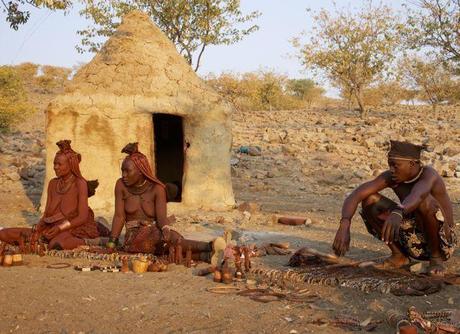Let me explain. The Himba are a semi-nomadic tribe living in the northwest region of Kunene, also referred to as Kaokoland in Namibia. This region only has a population density of one person per every 2 square kilometres. As a result of their isolation and secluded lifestyle they still hold to their culture and traditional way of life.

Famous Himba hair that is covered in ochre. I asked about their hair and learned that the ends are fake hair. When this women saw that I was trying to photograph her hair, she kept checking my pictures until she was satisfied that I had done her hair justice.
I know it’s rude to stare, but I couldn’t help it. I was transfixed at the Himba woman who greeted us with her ochre covered hair. I had never seen anything like it.
Meeting the Himba can also be a bit daunting though as Stone, the videographer on our group found out. She hopped in beside him, fluttering her eyelashes. Several minutes later she told the driver in her native tongue to tell him that he could rest his head on her shoulder if he wanted. A very now uncomfortable Stone diverted his eyes from her naked chest and replied No thank you, I have a girlfriend. Not to be deterred, and much to the amusement of the rest of our group, she persisted while the driver translating. Although no translation was needed to know that she had a thing for Stone. Or at least she did from our western perspective. Perhaps her behavior meant something else only to the Himbas.

Stone making friends with a Himba woman.
We hopped off the jeep, arriving at a village where we were greeted by more shirtless Himbas. Each person came up to each of us, greeted us with a handshake while stating their name, their eyes questioning us for our names. It was an intense look, one that seemed to penetrate right through you. I’ll admit the look made me slightly uncomfortable, although I get the impression they were trying to be welcoming.

Mariana demonstrating how Himba women cover themselves in otjize, a mixture of butter fat and ochre
Next, Mariana an 18 year old Himba girl proceeded to demonstrate how the women cover themselves with otjize, a mixture of butter fat and ochre. It gives the skin a reddish tinge, and symbolizes the redness of the earth and the color of blood which symbolizes life. This is the Himba ideal standard of beauty – and not one I’ve seen anywhere else. This is also how the women clean themselves. They do not bathe, that’s reserved for the men only.

Ankle bracelets protect against venomous snakes and other animals in Namibia
If their habits seemed strange to us, they could say the same about us. Mariana asked each of us how old we were and if were married and had children. She kept shaking her head in disbelief as each of us said we didn’t have children. Himbas marry quite young and also have children at a young age.

I loved watching this little boy dance. He had rhythm and really seemed to be enjoying himself.
Without a doubt interacting with the children were my favorite part of my visit. They were expressive and much like the first Himba lady we met who was crushing on Stone, not shy.

Himba boy
Next up we headed over to another hut where the rest of the tribe had set up a make-shift market selling their hand-made goods. I did buy a couple of things and afterwards also made a donation when they danced for us but felt uncomfortable. Was this responsible tourism? It wasn’t like the time I’d spent earlier in Etosha National Park, or my visit to the Cheetah Conservation Fund. To me, it’s a gray area. The Himba directly benefit monetarily from tourists. They receive money from tourist visits and the drivers bring in heavy goods like bags of rice which save the women a day of walking. On the other hand, it’s very strange when a child who’s only contact with the outside world is tourists, tries to flick the screen on your iPhone to make the photo bigger. He didn’t quite have the technique down, but he certainly understood the concept. You could argue that change is coming one way or another isn’t it? On the other hand, shouldn’t tourists try and not accelerate it? Just let it happen on its own and to learn from it? But then what about the opportunity to interact with a culture so different from your own? Or are we just romanticizing the Himba? I couldn’t make up my mind about whether my visit was responsible tourism and several months later, it still leaves me unsettled.

The Himbas selling their handicrafts at the end of our tour.
Know Before You Visit the Himba People:
- Visits are only possible at certain times throughout the year due to their semi-nomadic lifestyle.
- It’s possible to visit the Himba from a variety of companies of which the list can be found on Nambia Tourism’s site.
- The cheapest way to get to the remote Kunene Region is to drive, but fly-in safaris are also available.
- I recommend staying at the Grootberg Lodge where we stayed. I loved my stay here. Note: there are no fences so it’s possible to encounter wild animals on the hotel grounds. Apparently there’s a leopard who enjoys hanging out by the pool at night.

